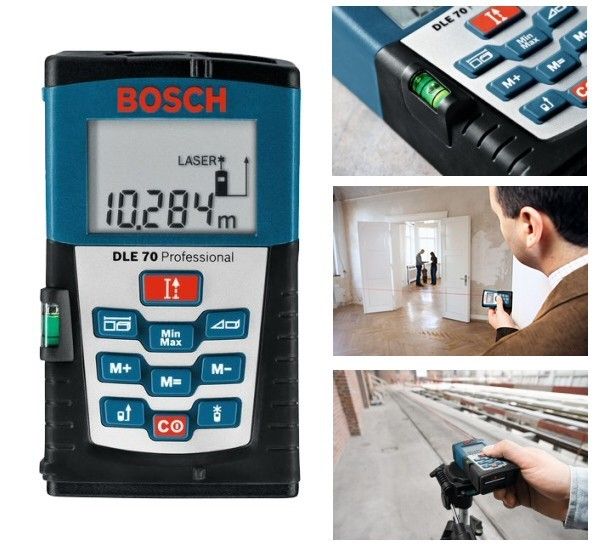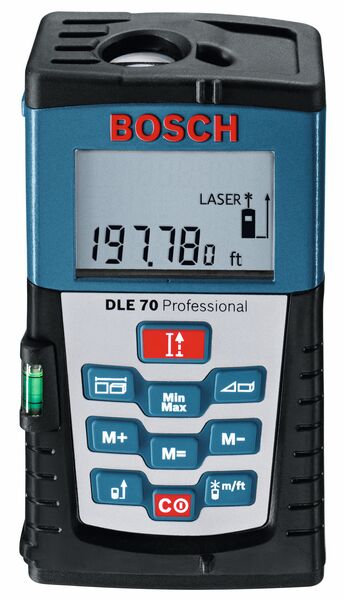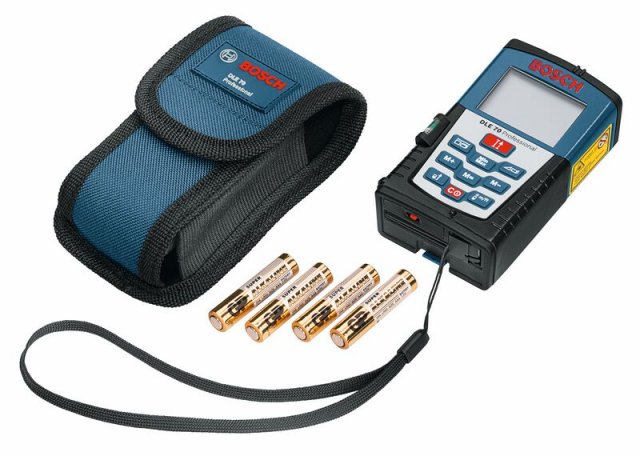Bosch DLE 70 Laser Distance Measuring Tool – The Tape Measure of the Future
Written by Vlad on April 29, 2011 – 9:58 pm - 11,570 views
The Bosch DLE 70 is a portable laser rangefinder (distance measurement device). You use it like a laser pointer to mark any target object whose distance you want to measure, and then press a button. The rangefinder will then display the distance to the target on the LCD display. The DLE 70 can measure any distance between 5cm and 70m with an accuracy of plus/minus 1.5mm. This is a fantastic replacement for tape measures and ultrasonic distance measuring tool.
It weighs 185g (6.3oz) and is powered by 4 AA batteries. It dimensions are 9.8cm x 5.8cm x 2.7cm (3.86in x 2.28in x 1.08in) – about the size of two small tape measures next to each other – and it comes with a handy belt holster.
It retails in Australia for around $270. I purchased it on eBay for $170, inclusive of shipping.
Why I bought a Laser Distance Measuring Tool
I hate measuring tape. I have been doing some renovation and reorganizing inside my home, and I’ve had to pull out the measuring tape. I really hate that when you measure something long, the tape bends and collapses. Also, you often have to ask someone to help you, which embarrasses you and inconveniences them. I wanted a better solution.
A little while ago, I was looking to rent an office space with a few potential partners who also develop Internet-based businesses. We inspected a location in Ultimo that was advertised as being 80 square metres in size. One of my partners borrowed a laser distance measuring tool, and did his own calculation of the office area. To our shock, the area was only 65 square metres – the agent had overstated the area by 23 percent!
Naturally, we used this fact to negotiate a lower rent. Ultimately, the deal fell through for other reasons, but this tool prevented us from being ripped off. I thought to myself “if I can get one of those cheaply, I will definitely get one for myself.” eBay naturally came to the rescue.
How Ultrasonic and Laser Distance Measurement Devices Work
For many years, there have been electronic distance measuring tools that use ultrasound. They are in effect simple SONAR systems. Such devices typically use a piezo transducer to emit a high frequency chirp that bounces off a solid target, e.g. a brick wall, creating an echo, which is reflected back to the sender.
The ultrasonic tool measures the delay between when it sent the chirp and when the echo is received by a sensor (microphone or piezo receiver) inside the tool. This round trip time is halved and then multiplied by the speed of sound to calculate the distance to the target. At standard pressure (101.325kPa) and room temperature (20 degrees Celsius), sound travels at 343.2m/s. For example, if the echo was heard 1 second after the chirp was generated, you would expect that the distance would be half of 343.2m, which is 171.6m.
Laser distance measurement works in a similar way except that laser ranger finders uses the properties of laser light instead of sound. A laser range finder uses a laser diode to generate a pulse of light and it times how long it takes the pulse to be reflected off the target back towards the range finder, where it is detected by a light sensor. Light travels at 299,792,458m/s in a vacuum and approximately 299,702,547m/s in air at standard temperature and pressure. As this is almost a million times faster than sound, the timing technology required is much more sophisticated and precise. This makes laser rangefinders substantially more expensive than ultrasonic versions. Until recently, they were only affordable for military and aerospace applications, but technological advances have now made them affordable for individuals.
Why You Should Not Buy Ultrasonic Distance Measuring Tools
Although ultrasonic distance measuring tools are much cheaper, they have two big limitations:
1. Variations in the Speed of Sound Introduce Errors into the Measurement
The speed of sound varies greatly depending on the surrounding temperature, humidity and air pressure (directly related to your elevation from sea level).
At room temperature, 20 degrees Celsius, the speed of sound is 343.2m/s, but at 10 degrees, it is only 337.33m/s – a 1.73% reduction (check this handy speed of sound calculator here). Perhaps such errors may be tolerable, but for many applications, e.g. surveying or building, it is excessive.
To compensate for this, a sophisticated ultrasonic measurement tool would have to have at the very least, an inbuilt thermometer to reduce the error, or an option to let you specify the ambient temperature.
In contrast, the speed of light is far less sensitive to environmental variations in air pressure, temperature and humidity.
For those physicists amongst us, you will know that the speed of light inside a medium (i.e. air, glass, plastic) is a function of the wavelength of the light and its refractive index. Using monochromatic laser light ensures that the wavelength is consistent. The refractive index of air is usually taken as 1.0003, and it does not vary much. If you are mathematically inclined, you can find the formula to calculate the refractive index of air in this academic paper
2. Targeting Ultrasound is not Precise
Unlike laser light, it is very difficult to focus sound into a thin beam that can travel over a long distance. The ultrasound that is produced by ultrasonic measuring device travels in a shape more like an expanding cone. The sound can bounce off anything in its path, introducing errors into the measurement. When it reaches the target, it will reflect off all surface features. If you are trying to measure the distance to a wall, you may inadvertently get reflections from a nearby cupboard or book case.
Furthermore, you cannot see the objects that the sound wave is hitting. To overcome this, some ultrasonic range finders have laser pointers built into them, to make it easier to aim them in the correct direction. You must be aware that the laser is just a convenience tool, but it not actually used to measure the distance, so these devices still have all the drawbacks of ultrasonic distance measurement. BEWARE: Some unscrupulous sellers are calling these “laser range finders”. The giveaway is the low price and lack of a name brand.
Why You Should Buy Ultrasonic Distance Measuring Tools
The only reasons I can think for buying an ultrasonic range finder:
- You want to measure the distance to a target obscured by thick fog or smoke, which would block the passage of light, but allow sound to pass through.
- You really can’t afford to spend much money and don’t need high accuracy or precise targeting
Advantages of a Laser Range Finder Compared to a Tape Measure
- You don’t need someone else to hold the other end
- There is no metal tape to bend or collapse
- You don’t have to inspect the tape before retracting it. One the laser rangefinder has made a measurement, it will remain displayed
- You can measure the distance to objects in awkward and difficult to reach locations
Why I chose the Bosch DLE 70 Laser Rangefinder
Consumer and professional grade laser rangefinders vary greatly in price and features. Most of the ones I saw were between $100 and $1000.
Here are some features common to most models:
- Support for both metric and imperial units
- Selecting to measure the distance from either the front or back of the device
- Continuous measurement mode with the ability to record the minimum or maximum distance encountered
- A memory function (like on a calculator)
- Add and subtract measurements, for perimeter measurements or gap measurements
- Calculation of areas and volumes by taking
- Pythagoras (diagonal) measurement mode, where you measure the length of a diagonal and an adjacent side, and it calculates the length of the opposite side.
For $100, you can get the Prexiso X2, which can only measure distances up of 30m with an accuracy of +/- 3mm
For $860, you can get the Bosch GLM250VF, which can measure distances up to 250m with an accuracy of +/- 1mm. It also has a viewfinder to help you aim the laser beam
More expensive models could support distances of multiple kilometres and have the ability to record measurements and transfer them to a computer over a serial or USB cable.

In the end, I chose the Bosch DLE70 for the following reasons:
- Bosch is generally considered a quality brand when it comes to tools
- It can measure up to 70m, which should easily cover all distances I am likely to encounter
- The accuracy of +/- 1.5mm is very good
- I figured that $200 was a reasonable budget for me, and the next model above would cost over $350 – almost double
- It is splash proof and can withstand a drop from 1 metre without being damaged
- It has a spirit level on the side that helps ensure that you are holding it horizontally
- It has a tripod screw at the bottom, which is compatible with any standard camera tripod, and you can choose to offset the measurement from that location
- It has a retractable corner pin located on the bottom edge. You use it when you want to measure a distance from a narrow confined corner, and you can choose to offset the measurement from the end of the pin

Results of Tests Performed with the Bosch DLE 70
Laser distance measuring tools are fun to use. You get an urge to point it at anything and everything in the most unusual locations to see exactly how far away they are. Here’s a few things I have learnt while testing the Bosch DLE 70:
- If you try to measure an object that is less than 5cm away from the front of the device, it will display an error
- If you try and measure an object that is more than 70m away from the front of the device, it will display an error
- If you try and measure an object that is located on the other side of a glass window or door, some of the beam will reflect off the glass. In that case, you will either get the correct distance to the object, or the distance between the DLE 70 and the glass window or door. This depends on how clean the glass is, and how much ambient light there is inside and outside.
- If you try and measure the distance to an object that you see reflected in a mirror, you will get the correct result – the distance between you and the mirror plus the distance between the mirror and the object
Measuring the length of a surface that is parallel to the beam
Measuring the distance to a perpendicular surface like a wall is easy, as you have a target to point the laser at. But what do you do when you want to measure the length of a table, or any surface that is parallel to the beam? Here are my suggestions:
If you want to measure the length of a table or another surface parallel to the beam, you will need to have something at the other end to point at. Here are some solutions:
- If you are measuring a horizontal surface like a table top, you can push the object up against a wall, and then measure the distance to the wall.
- If you can place one end of the on the floor, you can measure the distance from a point on the object to the floor
- If the object is small, you can simply place the palm of your hand on the other side of the object you want to measure, and then aim the beam at your hand.
- Otherwise, you can use any object as a target, e.g. a pencil eraser or book end. If needed, you can hold it in place with sticky tape or Blu-Tack
Example Uses for a Laser Range Finder
- If you are a seller or landlord, you can use the laser rangefinder to measure the area of your home of office prior to sale or leasing
- If you are a buyer or renter, you can use the laser rangefinder to ensure that you have been accurate information about the area, and possibly negotiate a better price
- If you are painting walls, you can quickly work out the surface area of your walls to work out how many tins of paint you need to buy
- If you are building a structure, you can quickly survey the environment to work out what sized lengths of material you will need, e.g. metal poles, timber beams
- Using mapmaking software and a magnetic compass and/or GPS unit, you can use the laser rangefinder to help build accurate maps of buildings, campuses or even caves
Tags: bosch, laser, laser pointer, measuring tool, rangefinger
Posted in Tools | 2 Comments »



By Jacob on Sep 30, 2011 | Reply
How far these tools can be used to measure kilometer from the target object? I very helped by the information that you provide this. This tool can simplify my work in the field of contracting. Thank you for your posting.
By Vlad on Oct 6, 2011 | Reply
As mentioned, the Bosch DLE 70 only measures up to 70m.
Bosch’s most powerful model, the GLM 250 VF, can measure up to 250m, and it sells for around $500.
For greater distances, you will need to look at another brand, and if you need over 1km, the price is likely to be over $1000.
[geobay]search=bosch glm 250[/geobay]